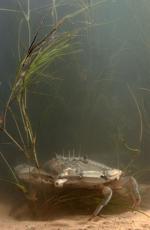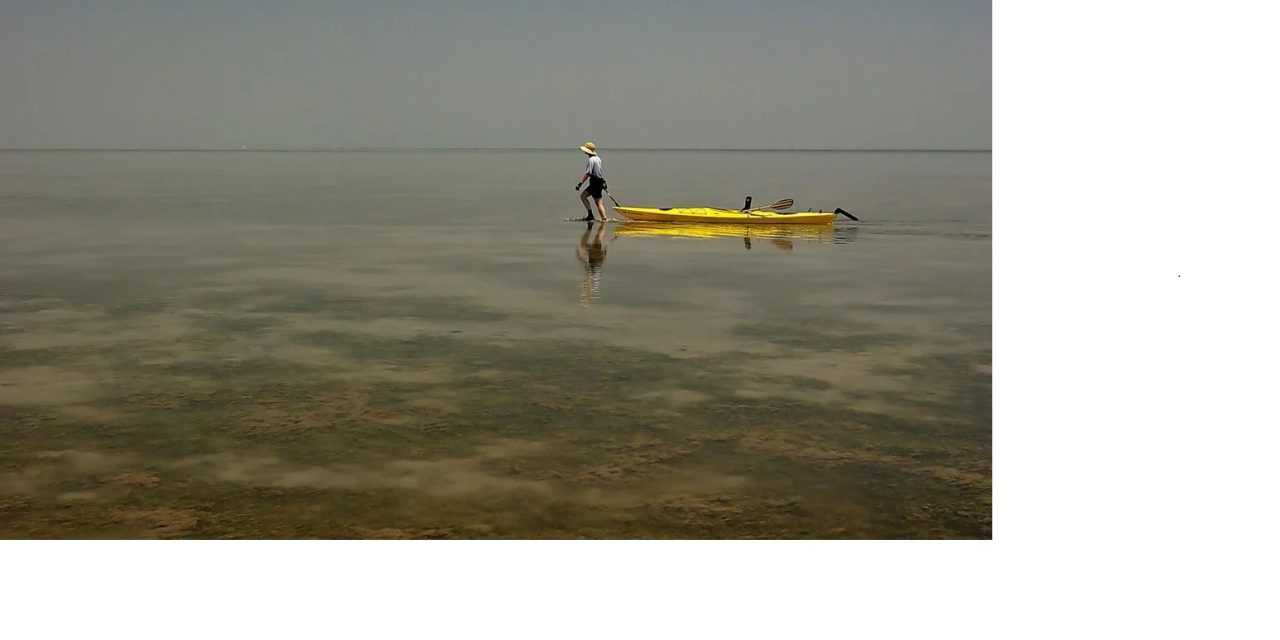But a new report from some of the Bay’s top scientists says those results are both more difficult and uncertain than originally thought. It suggests that major adjustments are needed in existing programs — and perhaps public expectations — to improve the Chesapeake’s health.
The 114-page report casts doubt that the decades-old goal of eliminating low oxygen “dead zones” in the deepest part of the Bay is achievable, at least without new technologies.
And it says existing programs designed to curb urban and farm runoff are unlikely to attain their nutrient reduction goals, even with increased funding.
It’s also unclear whether achieving those nutrient reductions, by themselves, would greatly improve aquatic life in the Bay.

Blue crabs are among the Chesapeake Bay’s living resources that depend on healthy shallow water habitat. Bay Journal photo by Dave Harp
But the report from the Chesapeake Bay Program’s Scientific and Technical Advisory Committee also says opportunities exist to improve aquatic habitat, largely by refocusing efforts on shallow areas and combining them with other habitat improvements, such as restoring wetlands and protecting shorelines.
Those improvements would take time and, in some cases, require rethinking how Bay-related programs operate. For instance, the report says, some of the money directed toward nutrient reductions might be more effectively used to restore habitats.
Most fundamentally, the report suggests it is time to stop thinking about Bay “restoration.” A theme throughout the report is that the future Bay should be healthier than it is today, but it will not be the Chesapeake of the past.
Climate change has brought warmer water temperatures, higher sea levels and new precipitation patterns. The Bay’s 64,000-square-mile watershed is home to a growing number of people and farm animals, and it contains huge swaths of land permanently altered by development. Those changes “challenge the notion of restoration based on recreating historical conditions,” the report said.
“This whole idea that the Bay of the future is not going to look like the Bay of the past is a big pill to swallow,” acknowledged Denice Wardrop, director of the Chesapeake Research Consortium, which helps coordinate Bay-related activities at research institutions. “There’s just no way to return. It’s just a different world.”
That doesn’t mean giving up on Bay improvements, she added. “We’re not going to stop, but there are signals that we could be doing things better, and how we can do that.”
Shaping Bay discussions
The report comes at a significant moment for the state-federal Bay Program, launched 40 years ago to improve water quality and reverse the decline of its living resources.
The program recently acknowledged that it will miss its 2025 deadline for nutrient reductions and other restoration milestones, such as those for streamside forest buffers and wetlands. As a result, the Bay Program recently launched a “beyond 2025” planning effort to decide what should happen after that date.
The new report, Achieving Water Quality Goals in the Chesapeake Bay: A Comprehensive Evaluation of System Response, could shape those discussions. It took more than four years to develop and is the first major scientific consensus report about the Bay in decades. More than 60 current and former members of the independent scientific advisory committee signed onto it.
It’s already getting a close look by others. Hilary Falk, president of the Chesapeake Bay Foundation, the region’s largest environmental organization, said the report “highlights the enormity of the challenges we still face while providing incredible insight into where we might refocus our efforts. It should be required reading for everyone in the Bay movement.”
Work on the report was launched to understand why progress toward meeting Bay water quality goals has been slower and more difficult than expected and how efforts to improve the nation’s largest estuary and its living resources could be improved.

Bay nutrient reduction goals are loosely based on attaining water quality conditions that existed in the 1950s, before nutrient pollution began to increase dramatically. The goals are intended to reduce the amount of nutrients — nitrogen and phosphorus — flowing into the Bay, where they stimulate algae growth.
Algae is a critical fuel for the Bay’s food web. But excess amounts result in harmful algal blooms that block sunlight to underwater grasses. They also rob the water of oxygen as they decompose, causing dead zones that are off limits to most aquatic life.
While some areas have had modest benefits, nutrient reductions to date have not produced significant baywide improvements in water quality, the report said, at least as measured by dissolved oxygen concentrations and water clarity. That’s especially true for deep areas of the upper Bay, it noted.
Only 27% of the Bay fully met clean water goals in the mid-1980s, and that has only increased to the mid-30% range.
Part of the reason could be that nutrient reductions have not been great enough to trigger significant overall water quality improvements. But other factors, such as climate change, may be offsetting the impact of nutrient reduction efforts. Warmer water holds less oxygen, and rainfall has increased, washing more nutrients off the land and into the Bay.
Because of climate and land use changes, the report says, attaining water quality goals in some parts of the Bay, especially deep areas, may not be possible with existing technologies.
Most nutrient reductions so far have come from upgrades at wastewater treatment plants that cut nitrogen and phosphorus discharges, and from air pollution controls that reduced nitrogen emissions from burning fossil fuels.
Because most of the anticipated reductions from those sources have been realized, future reductions depend on reining in runoff from agricultural and urban areas. Those sources, though, are difficult to control because they involve dispersed sources of runoff from large areas of the landscape.
Runoff control challenges
The report says that efforts to control runoff from farms, which are by far the largest source of nutrients, are being at least partially offset by increases in animal numbers and the intensification of agriculture (see Chesapeake Bay cleanup faces difficult trade-offs with agriculture).
It also cautions that runoff controls are likely less effective than indicated by the computer models used to estimate cleanup progress. That’s especially true for phosphorus: the models show significant improvements while monitoring in the Bay and its rivers shows little change in the last two decades.
The report says that existing agricultural programs, which rely largely on voluntary use of best management practices like cover crops and streambank fencing, are unlikely to be implemented at the widespread levels needed to achieve nutrient reduction goals. That’s especially true in areas of the Bay region that have intense animal production and generate far more manure than is needed by croplands.
The Bay is not alone in this situation, the report notes. There are few examples elsewhere of places and programs that have achieved significant watershed-scale nutrient reductions in such circumstances. But the report says new approaches could be tested in the Bay region.

Certain parts of the landscape, for instance, produce disproportionate amounts of nutrient-laden runoff simply because of their topography and soil types. Programs could target those areas more precisely to offer increased incentives for pollution reductions by certain communities and farms.
“You have to create a different incentive structure and crediting structure to have targeting be a viable option,” said Zach Easton, a Virginia Tech agriculture professor who was a co-author of the report. “I can envision lots of different forms that could look like. But you can’t treat all areas of a landscape or all actors, equally because they don’t function or process nutrients equally.”
The report also says new strategies are needed to deal with excess manure, which could include subsidizing the export of more manure to other areas or using technologies to treat animal waste.
“Animals produce 10 times more manure nutrients than humans in the watershed,” Easton said. “We should be treating [those nutrients] as a waste. That’s an expensive proposition, so we’re likely not going to do it.”
The report suggests small-scale testing of different approaches to controlling runoff. If successful, the lessons learned could be more widely applied. But it would be a long process.
Kurt Stephenson, an agricultural economist with Virginia Tech and a co-author of the report, said it could take 10–15 years of water quality monitoring to determine whether a novel approach was having a measurable impact at a smaller scale, and longer to then apply those lessons to other sites.
“People need to adjust their expectations about how fast things can happen when you’re dealing with 18 million people in a landscape that large,” Stephenson said. “There’s not going to be any silver bullets, and people should understand it’s going to be a slog.”
Helping aquatic resources
The report also says it is difficult to predict how fish, shellfish and other living resources would respond to improved water quality conditions in the future, largely because they are subject to so many other stresses. Shorelines are hardened, tidal wetlands are declining, oyster reefs are near historic lows and underwater grass beds are far below the regionwide goal.

But there is hope. Even if the region does not meet its nutrient reduction and water quality goals, the report says, other efforts to improve, protect and restore habitats could help increase the abundance of fish, crabs, oysters and other living resources.
“We could be getting appreciable living resource benefits without reaching full water quality attainment,” Wardrop said.
In fact, the report indicates that over-emphasizing nutrient reduction goals could “divert attention away from considering multiple means of improving living resources.”
When the region adopted legally binding goals in 2010 as part of the Bay’s total maximum daily load, or “pollution diet,” it put the focus — and funding — on nutrient reduction as the primary means to bolster living resources.
Instead, the report says, a policy challenge facing the Bay Program is “how to allocate restoration funds and efforts to generate the largest living resource impacts for the most stakeholders.”
The report suggests switching to a “tiered approach” for management. Right now, nutrient reductions are largely focused on restoring water quality in the deepest part of the upper Bay, where conditions are poorest and least likely to rapidly respond.
Alternatively, the report says greater emphasis could be focused on shallow areas of the Bay — places where improvements would likely be seen more quickly and that serve as more important habitats for fish and other aquatic life. Those nutrient reduction efforts should be paired with other projects to improve habitats in those areas, the report said.
According to the report, there is evidence that such an approach could provide tangible benefits from nutrient reductions in shorter periods of time.
The report cites Mattawoman Creek, a Maryland tributary to the Potomac, as an example. After a wastewater treatment plant there was upgraded, algae concentrations began dropping in the creek. In several years, underwater grass beds — a critical habitat for many species — began to rebound, increasing from 50 acres to more than 300 acres.

“If you look at the shallows, there are a combination of things going on,” Wardrop said. “It’s the first place where you see the impacts of climate change. It’s at a scale where people feel they can manage it and do things differently. It’s where the stakeholders are. It’s where you will get water quality improvements sooner. And eventually those improvements will cascade down to the deep channel.”
One thing is certain. The effort will take time.
“Achieving reductions in pollutants and realizing improvements in water quality and living resources in a system as large, diverse, and complex as the Bay watershed and estuary calls for patience as changes are planned and implemented and the systems responds,” the report cautions.




Recent Comments